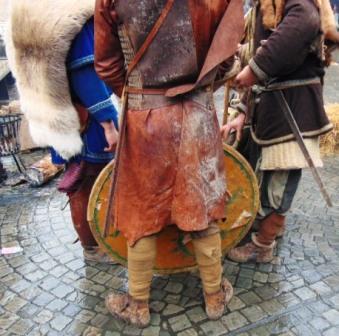People do not have fur. Our (remaining?) hair does not protect against sunlight, torrential rain or cold. To protect us, we use the skin of other animals.
Whether the hair: wool. Or felt.
 But especially from plant fibers, we have learned to make threads and process them into textiles, clothing, tents, bags etc. In all cultures we often find it, with beautiful colors and woven patterns.
But especially from plant fibers, we have learned to make threads and process them into textiles, clothing, tents, bags etc. In all cultures we often find it, with beautiful colors and woven patterns.
High in the mountains it is colder than at sea level. The temperature decreases by 0.6 degrees C per 100 meter rise. (Also depending on wind, humidity etc.) If you mount one kilometer, you should count on a cooling of about 6 degrees C.
Wind has a cooling effect that should not be underestimated. If it is 10⁰C with no wind, it cools by a wind of 28 km/ h to 0⁰C, and at 48 km/ h it freezes at -3⁰C. You may notice this yourself if you stick your hand out the car window.
Biking you experience the cooling effect is strong, and you will notice much difference between 10 and 20 km/ h.
As we previously biked to school in the winter, we crossed two or three layers of newspaper under our jersey. There no wind passed. And that really makes a difference. Moon boots did not exist, but our feet we packed in layers of newspaper before they went into a rubber boot. A huge difference. (As long as the paper stays dry!) Layered stagnant air isolates excellent. Test it.
One day cycling on Wadden islands once literally cost me my (burnt) sheet. I do no longer underestimate the cooling effect of wind.
Cold and cooling
If you get hypothermia, you can die.
In (cold) water, or when you are wet, you will discharge body heat 30 times faster. So try to stay dry especially when cold, even by not sweating from exertion. The moisture demolishes the insulation value of your clothing.
Your normal body temperature is 35.5 to 37.5⁰C.
Between 35 and 32⁰C, you start to shiver: move your muscles to generate heat.
It becomes critical from 32 to 28⁰C, your heart rate, respiration and metabolism are slower, you feel drowsy.
Below 28⁰C you become unconscious, paralyzed and death. There is an urgent need of medical care. Gradually warming comes better from within: breathing warm air, have warm drinks. (Certainly no alcohol!) Alcohol can dilate blood vessels close to the skin, but in reality will thus even lower the body temperature.
Most heat is loosed at the head (because it is uncovered).
Your body is trying to maintain its core temperature (vital organs, brains).
In cold, extremities get increasingly relied less blood and die if you can’t do anything.
Tingling fingers mean that the blood had been already withdrawn from your extremities, and now flows back again after warming.
To prevent losing heat it is fundamentally to stay dry in cold weather. So also avoid too sweat.
Protrusions as nose, toes and fingers will freeze first. The cells will crystallize in the absence of blood (flow). You have died of hypothermia before you freeze.
Most heat is lost via the head. If it’s cold, so first care for a hat, cap or any (dry) cover.
Clothes: mask of the body. (Jan G. Elburg)
"I tend to sleep in the nude. Which isn't a bad thing except for maybe on those long flights."
